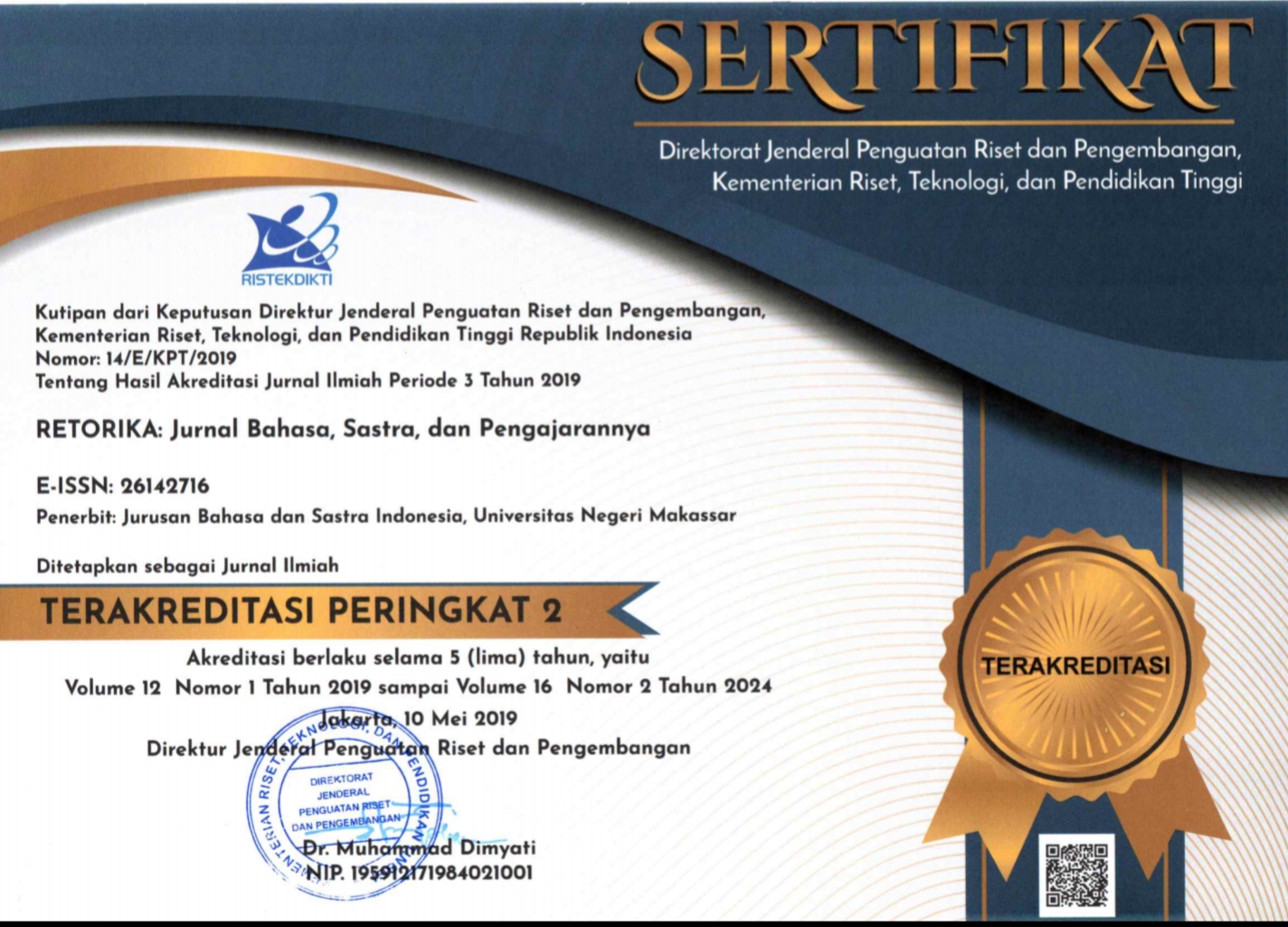PRODUKSI KOSAKATA ANAK MELALUI ELECTRONIC WORDLESS PICTURE STORYBOOK
(1) Universitas Negeri Yogyakarta
(2) Universitas Negeri Yogyakarta
(*) Corresponding Author
DOI: https://doi.org/10.26858/retorika.v11i2.6405
Abstract
Children’s Vocabulary Production through Electronic Wordless Picture Story-book. This study aims to reveal the effectiveness of the use of electronic wordless picture storybook to improve the production of children's vocabulary. We compared a printed wordless story-book and an electronic wordless storybook. The quasi-experiment research with one group posttest design only was used in this study. The subjects were six teachers and 59 children aged 24-48 months. Samples were taken using a saturated sample technique in three early childhood educational institutions. The instrument used was an observation sheet. The data were then analyzed using the Mann Whitney Test. The result was an electronic wordless picture storybook more ef-effective to produce children's vocabulary.
Keywords
Full Text:
PDFReferences
Chaparro-Moreno, L. J., Reali, F., & Maldonado-Carreño, C. 2017. Wordless Picture Books Boost Preschoolers’ Language Production During Shared Reading. Early Childhood Research Quarterly, 40: 52–62.
Ciampa, K. 2012. Electronic Storybooks: A Constructivist Approach to Improving Reading Motivation in Grade 1 Students. Canadian Journal Of Education, 35(4): 92–136.
Conrad, N., & Tracy, B. (2016). The Literacy Skills and Motivation to Read of Children Enrolled in Title I : A Comparison of Electronic and Print Nonfiction Books. Early Childhood Education Journal, 44(5): 527–536. doi:10.1007/ s10643-015-0735-0.
Evans, M. A., Nowak, S., Burek, B., & Willoughby, D. 2017. The Effect of Alphabet eBooks and Paper Books on Preschoolers’ Behavior: An Analysis Over Repeated Readings. Early Childhood Research Quarterly, 40: 1–12.
Hughes, C.A. 2003. E-books. In Drake, M.A. (Ed.). Encyclopedia of Library an Information Science (2nd ed.) New York: CRC Press
Korat, O., & Blau, H. 2010. Repeated Reading of CD-ROM Storybook as a Support for Emergent Literacy: A Developmental Perspective in Two SES Groups. Journal Of Educational Computing Research, 43(4): 445–466. doi:10.2190/ EC.43.4.b
Korat, O., & Shamir, A. 2012. Direct and Indirect Teaching: Using E-Books for Supporting Vocabulary, Word Reading, and Story Comprehension for Young Children. Journal Of Educational Computing Research, 46(2): 135–152.
Matthew, K. 2015. A Comparison of the Influence of Interactive CD- ROM Storybooks and Traditional Print Storybooks on Reading Comprehension A Comparison of the Influence of Interactive CD-ROM Storybooks and Traditional Print Storybooks on Reading Comprehension, (online). https://doi.org/10. 1080/08886504.1997.10782198
Montgomery, A. P., & Smith, K. M. 2014. Building Literacy Relationships with Song-Based Picture Books. Language and Literacy, 16(3): 27–54.
Newton, D.P. (1992) Pictures in Books for Children at Key Stage 1: an analysis, Educational Studies, 18(3):253-265, doi: 0.1080/0305569920180301
Prasetya, D. -D., & Tsukasa, H. 2018. Design of Multimedia-based Digital Storybooks for Preschool Education. International Journal Of Emerging Technologies In Learning, 13(2):211–225. doi: 10.3991/ijet.v13i02.8188
Saracho, O. N. 2016. Parents’ Shared Storybook Reading: Learning to Read, Early Child Development and Care, 187 (3-4): 554-567. doi: 10.1080/03004430.2016.1261514
Shamir, A., & Korat, O. 2014. Developing an Educational E-Book for Fostering Kindergarten Children â€TM s Emergent Literacy Developing an Educational E-Book for Fostering Kindergarten Children ’ s Emergent Literacy. Interdisciplinary Journal of Practice, 24 (2): 37–41. doi:0.1300/J025v24n01.
Strasser, K., Larraín, A., & Lissi, M.R. 2013. Effects of Storybook Reading Style on Comprehen-sion: The Role of Word Elaboration and Cohe-rence Questions. Early Education and Deve-lopment, 24 (5): 616–639, doi: 10.1080/1040-9289.2012.715570
Torr, J., & Clugston, L. 1999. A comparison Between Informational and Narrative Picture Books As a Context for Reasoning Between Caregivers and 4‐Year‐Old Children. Early Child Deve-lopment and Care, 159 (1): 25–41.
Whorrall, J., & Cabell, S. 2016. Supporting Children's Oral Language Development in the Preschool Classroom. Early Childhood Education Jour-nal, 44 (4): 335–341. doi:10.1007/s10643-015-0719-0
Widodo. 2016. Bimbingan Tek-nik bagi Petugas Pengelola Perpustakaan Sekolah. Diakses dari https://library.uns.ac.id/wp-content/uploads/ 2016/04/EBOOK.pdf
Article Metrics
Abstract view : 1386 times | PDF view : 262 timesRefbacks
- There are currently no refbacks.
Copyright (c) 2018 Nurul Arifiyanti, Kartika Ananda

This work is licensed under a Creative Commons Attribution-NonCommercial 4.0 International License.
Published by:
Department of Indonesian Language, Faculty of Languages and Literature, Universitas Negeri Makassar in cooperate with Asosiasi Dosen Bahasa dan Sastra Indonesia (ADOBSI) and Ikatan Program Studi Pendidikan Bahasa dan Sastra Indonesia (IKAPROBSI).
Address: Department of Indonesian Language Office, DG Building Second Floor, UNM Parangtambung, Daeng Tata Raya Street, Makassar, South Sulawesi, Indonesia
 Email: retorika@unm.ac.id
Email: retorika@unm.ac.id

RETORIKA: Jurnal Bahasa, Sastra,dan Pengajarannya is licensed under a Creative Commons Attribution-NonCommercial 4.0 International License.
















